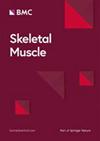MuSK-BMP通路通过调节Akt-mTOR信号维持慢肌肌纤维的大小
IF 4.4
2区 医学
Q2 CELL BIOLOGY
引用次数: 0
摘要
肌纤维大小调节对健康、疾病和衰老至关重要。MuSK(肌肉特异性激酶)是一种 BMP(骨形态发生蛋白)共受体,可促进和形成 BMP 信号传导。MuSK 表达于所有神经肌肉接头处,也存在于小鼠比目鱼肌的突触外,其主要的氧化纤维组成与人类肌肉相似。为了研究 MuSK-BMP 通路在体内的作用,我们培育了缺乏 BMP 结合 MuSK Ig3 结构域的小鼠。这些ΔIg3-MuSK小鼠具有生存能力和繁殖能力,其神经支配水平与野生型相当。在 3 个月大的小鼠中,慢速比目鱼肌的肌纤维较小,而快速胫骨前肌(TA)的肌纤维较小。转录组分析显示,比目鱼选择性地减少了核糖核酸代谢和蛋白质合成途径,以及 IGF1-Akt-mTOR 途径成分的失调。生化分析表明,Akt-mTOR 信号在比目鱼肌中减少,但在腓肠肌中没有减少。我们认为,MuSK-BMP通路通过促进蛋白质合成通路(包括IGF1-Akt-mTOR信号转导),在突触外维持慢肌肌纤维的大小。这些结果揭示了一种调节慢肌肌纤维大小的新机制,并将 MuSK-BMP 通路作为促进肌肉生长和对抗肌肉萎缩的靶点。本文章由计算机程序翻译,如有差异,请以英文原文为准。
The MuSK-BMP pathway maintains myofiber size in slow muscle through regulation of Akt-mTOR signaling
Myofiber size regulation is critical in health, disease, and aging. MuSK (muscle-specific kinase) is a BMP (bone morphogenetic protein) co-receptor that promotes and shapes BMP signaling. MuSK is expressed at all neuromuscular junctions and is also present extrasynaptically in the mouse soleus, whose predominantly oxidative fiber composition is akin to that of human muscle. To investigate the role of the MuSK-BMP pathway in vivo, we generated mice lacking the BMP-binding MuSK Ig3 domain. These ∆Ig3-MuSK mice are viable and fertile with innervation levels comparable to wild type. In 3-month-old mice, myofibers are smaller in the slow soleus, but not in the fast tibialis anterior (TA). Transcriptomic analysis revealed soleus-selective decreases in RNA metabolism and protein synthesis pathways as well as dysregulation of IGF1-Akt-mTOR pathway components. Biochemical analysis showed that Akt-mTOR signaling is reduced in soleus but not TA. We propose that the MuSK-BMP pathway acts extrasynaptically to maintain myofiber size in slow muscle by promoting protein synthetic pathways including IGF1-Akt-mTOR signaling. These results reveal a novel mechanism for regulating myofiber size in slow muscle and introduce the MuSK-BMP pathway as a target for promoting muscle growth and combatting atrophy.
求助全文
通过发布文献求助,成功后即可免费获取论文全文。
去求助
来源期刊

Skeletal Muscle
CELL BIOLOGY-
CiteScore
9.10
自引率
0.00%
发文量
25
审稿时长
12 weeks
期刊介绍:
The only open access journal in its field, Skeletal Muscle publishes novel, cutting-edge research and technological advancements that investigate the molecular mechanisms underlying the biology of skeletal muscle. Reflecting the breadth of research in this area, the journal welcomes manuscripts about the development, metabolism, the regulation of mass and function, aging, degeneration, dystrophy and regeneration of skeletal muscle, with an emphasis on understanding adult skeletal muscle, its maintenance, and its interactions with non-muscle cell types and regulatory modulators.
Main areas of interest include:
-differentiation of skeletal muscle-
atrophy and hypertrophy of skeletal muscle-
aging of skeletal muscle-
regeneration and degeneration of skeletal muscle-
biology of satellite and satellite-like cells-
dystrophic degeneration of skeletal muscle-
energy and glucose homeostasis in skeletal muscle-
non-dystrophic genetic diseases of skeletal muscle, such as Spinal Muscular Atrophy and myopathies-
maintenance of neuromuscular junctions-
roles of ryanodine receptors and calcium signaling in skeletal muscle-
roles of nuclear receptors in skeletal muscle-
roles of GPCRs and GPCR signaling in skeletal muscle-
other relevant aspects of skeletal muscle biology.
In addition, articles on translational clinical studies that address molecular and cellular mechanisms of skeletal muscle will be published. Case reports are also encouraged for submission.
Skeletal Muscle reflects the breadth of research on skeletal muscle and bridges gaps between diverse areas of science for example cardiac cell biology and neurobiology, which share common features with respect to cell differentiation, excitatory membranes, cell-cell communication, and maintenance. Suitable articles are model and mechanism-driven, and apply statistical principles where appropriate; purely descriptive studies are of lesser interest.
 求助内容:
求助内容: 应助结果提醒方式:
应助结果提醒方式:


